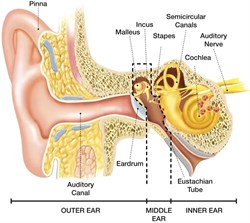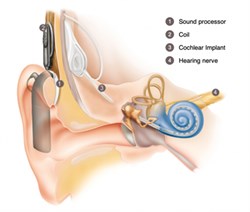Cochlear Implants
What do we hear?

In a hearing ear, sound waves travel along the ear
canal and bounce against the
eardrum. This causes the
eardrum and the chain of tiny bones
(malleus, incus and stapes) to
vibrate slightly. These vibrations ripple through the fluid in the
inner ear or cochlea, stimulating
thousands of tiny hair cells. This triggers an electrical response,
which is sent up the hearing nerve (auditory
nerve) to the brain, and sound is heard.
The tiny hair cells are essential. In people with a severe or
profound hearing loss, the hair cells may be damaged or absent, so
the sound signal cannot reach the nerve of hearing.

What is a cochlear implant?
Cochlear implants are electronic devices that can help
profoundly and severely deaf people to hear.
There are different types of cochlear implant, but they all have
internal and external parts.
The internal part consists of a receiver and an electrode
array. These are implanted during surgery. The receiver goes
under the skin, just behind the ear. The electrode goes deep inside
the cochlear - (inner ear).
The external part consists of a transmitter coil, a lead and a
sound processor with microphone and battery. These are fitted and
tuned about one month after surgery. The transmitter coil is held
in place by a magnet. The sound processor is usually worn over the
ear like a hearing aid.
How does the cochlear implant work?
- Sounds are picked up by the microphone in the speech
processor.
- The speech processor analyses the sound and converts it into a
special pattern of digital information.
- This information is then sent to the coil and is transmitted
across the skin to the implant.
- The implant interprets the code and sends electrical pulses to
the electrodes in the cochlea.
- The nerve endings in the cochlea are stimulated and the message
is sent along the hearing (auditory) nerve to the auditory centre
in the brain.
Who may benefit from a cochlear implant?
People with profound or severe hearing losses may benefit from a
cochlear implant. This includes adults and older children who have
lost their hearing, and young children who were born deaf.
A careful assessment is necessary to ascertain whether you or
your child will benefit from an implant.
